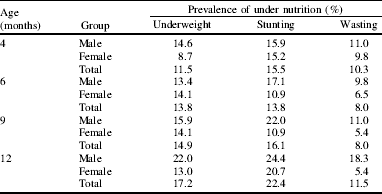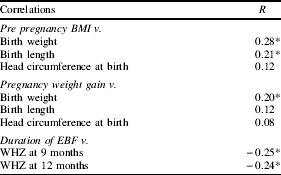The adverse birth outcomes result from insults occurred during the fetal life can have adverse influence on nutritional status at the young age(Reference McCarthy, Hughes and Tilling1). Adequate nutrition during infancy and early childhood is essential to ensure that children reach their full potential of growth and development. Infant and young child feeding practices have a direct influence on the nutritional status of children under two years of age(2). Body composition measurement gives an idea about effect of different nutritional regimens on the development of body composition(Reference Schmelzle and Fusch3). The objective of this prospective cohort study was to find out the association between maternal nutrition, infant feeding, birth characteristics and nutritional status and body composition during first year of life in term infants.
Term infants (n 200) at 4 months and their mothers registered in Pannala Medical Office of Health division in North Western Province in Sri Lanka were recruited and followed up until 12 months of age by home visits. Weight, length, mid-upper arm circumference (MUAC), head circumference and skinfold (tricep, and subscapular) thickness of infants (at 4, 6, 9 and 12 months of age) were measured. Pre-tested questionnaire was used to gather data on maternal nutrition, birth characteristics and infant feeding practices.
Prevalence of low birthweight (LBW) in the cohort was 16%. Prevalence of stunting in the cohort was greater than the prevalence of underweight and wasting (Table 1). Prevalence of 6-month exclusive breast feeding (EBF) was 63% and 70% of infants were introduced timely complementary feeding. Pre-pregnancy BMI and pregnancy weight gain showed significant (P<0.05) positive correlation with birthweight (Table 2). Birth characteristics did not show significant correlations with current nutritional status and body composition at any age (unpublished results). Duration of EBF showed significant (P<0.05) negative correlation with weight-for-length Z scores (WHZ) at 9th and 12th month (Table 2). WHZ and weight-for-age Z scores (WAZ) showed a significant (P<0.05) positive correlation with triceps skinfold-for-age (TSFZ) and subscapular skinfold-for-age (SSFZ) Z scores (unpublished results). Age-at-commencement of complementary feeding did not show a significant correlation with nutritional status and body composition. Infants with LBW had 2.56 times higher risk (relative risk=2.56, CI 1.06–6.23) of becoming stunted at the end of first year of life compared with normal birthweight infants.


* P<0.05.
In conclusion, maternal pre-pregnancy BMI and weight gain during pregnancy are significantly correlated with birth characteristics. Body composition of the infants is correlated with their current nutritional status. LBW is a significant predictor of stunting during infancy in the study population.




